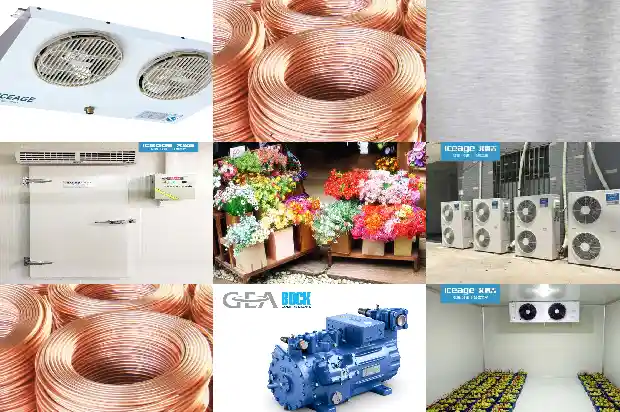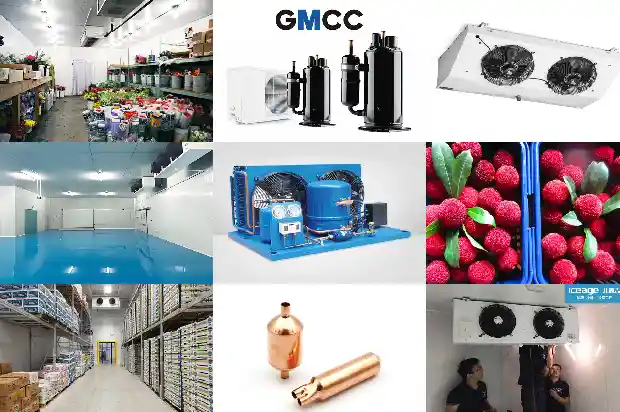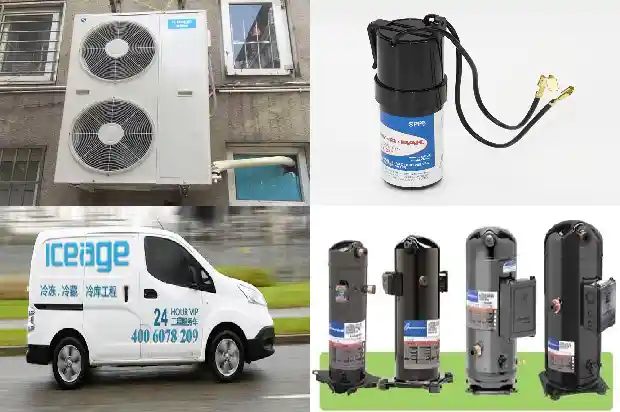Selection and Installation of Thermal Expansion Valves
2024-11-17
The thermal expansion valve is one of the four major components in a refrigeration unit. It plays a role in throttling and reducing pressure in the system and is also known as a throttle valve. In the systems of freezers and cold storages, the expansion valve is commonly used as the throttling element.
In a refrigeration system, the expansion valve is responsible for reducing the pressure of the high-pressure refrigerant liquid before it enters the evaporator, that is, reducing the condensing pressure to the evaporating pressure. According to the corresponding principle between saturated pressure and saturated temperature, the temperature of the refrigerant also decreases simultaneously. Meanwhile, the expansion valve also functions to control the flow rate of the refrigerant. The quality of the thermal expansion valve in the system will directly affect the operating performance of the entire system. Therefore, correctly selecting the thermal expansion valve will enable the evaporator to be fully utilized and always match the heat load, which is of great significance for the operating life, refrigeration effect and operating cost of the refrigeration system.
When the selection of the thermal expansion valve does not match the system, the refrigerant flow rate in the system will vary from time to time, resulting in the refrigeration capacity fluctuating. If the refrigeration capacity is too small, it will cause insufficient liquid supply to the evaporator and excessive superheat, which will have an adverse impact on the system performance. When the refrigeration capacity is too large, it will cause oscillations, intermittently resulting in excessive liquid supply to the evaporator, leading to violent fluctuations in the suction pressure of the compressor and even causing liquid refrigerant to enter the compressor, resulting in the phenomenon of liquid slugging (wet stroke) of the compressor.
When selecting a thermal expansion valve, factors such as the type of refrigerant, evaporation temperature, condensation temperature and evaporation load need to be considered. Generally, the selection is carried out through the following steps:
- Calculate the pressure drop across the valve.
Firstly, calculate the difference obtained by subtracting the evaporation pressure from the condensation pressure, and then subtract all other pressure losses from this difference to obtain the net pressure drop across the valve. Meanwhile, all the following possible sources of pressure drop should also be considered:
a. Friction losses when flowing through the refrigerant pipelines including the condenser and the evaporator;
b. Pressure drops when flowing through liquid pipe fittings such as solenoid valves and filter-driers;
c.
Static pressure drop (rise) values caused by the vertical lift (drop) of the liquid pipe;
d. If a distributor is used, the pressure drop when flowing through the refrigerant distributor should also be considered. - Determine the temperature of the refrigerant entering the valve.
- Select the valve from the refrigeration capacity reference tables of various series of valves. Select the valve according to the designed evaporation temperature and the pressure drop across the valve. If possible, the refrigeration capacity of the valve should be equal to or slightly greater than the designed rated value of the system. For a system with multiple evaporators, each valve should be selected according to the refrigeration capacity of each evaporator.
- Determine whether an external equalizing pipe is needed. Determine whether an external equalizing pipe is needed through the pressure drop between the outlet of the valve and the location where the sensing bulb is installed.
- Select the valve body. Select the form of the valve body according to the required connection form.
Connection mode between the expansion valve and the evaporator:
The thermal expansion valve must be installed on the liquid pipeline located in front of the evaporator.
The thermal expansion valve must be installed on the liquid pipeline located in front of the evaporator.

The thermal expansion valve senses the temperature at the outlet of the evaporator through the sensing bulb, converts this signal into the pressure of the vapor inside the sensing bulb, and then controls the opening degree of the valve needle of the expansion valve to achieve the purpose of feedback regulation. Therefore, the sensing bulb should be closely attached to the wall of the suction pipeline. Meanwhile, in order to prevent the sensing bulb of the expansion valve from being affected by the external temperature, after the sensing bulb is fixed, it needs to be insulated from the outside with a non-absorbent and heat-insulating material.
During the operation of the system, generally, the appropriateness of the adjustment size of the thermal expansion valve can be judged by observing the frosting situation on the outside of the valve body:
A. If the entire expansion valve body is frosted, it indicates that the flow rate is too small and should be adjusted appropriately larger. If the frosting shape remains unchanged after being adjusted larger, it may be that the throttling hole of the expansion valve is partially blocked and should be cleaned.
C. If only the outlet side of the expansion valve body is frosted, it indicates that the flow rate is too large and should be adjusted smaller.
D. If the outlet side and the lower part of the expansion valve body are frosted in a 45-degree inclined shape and the inlet side is not frosted, it indicates that the adjustment is accurate and appropriate.
E. If only the inlet side of the expansion valve body is frosted, it indicates that the filter screen at the inlet of the valve body is partially blocked and should be cleaned.
F. If the expansion valve body is completely frost-free, it indicates that there is no flow. It may be that the refrigerant in the system leaks, or the stop valve in the pipeline is not opened, or the capillary tube of the temperature sensing probe of the expansion valve leaks gas, or the throttling hole of the expansion valve is blocked, or the filter screen at the inlet of the valve body is blocked and should be cleaned.
A. If the entire expansion valve body is frosted, it indicates that the flow rate is too small and should be adjusted appropriately larger. If the frosting shape remains unchanged after being adjusted larger, it may be that the throttling hole of the expansion valve is partially blocked and should be cleaned.

C. If only the outlet side of the expansion valve body is frosted, it indicates that the flow rate is too large and should be adjusted smaller.
D. If the outlet side and the lower part of the expansion valve body are frosted in a 45-degree inclined shape and the inlet side is not frosted, it indicates that the adjustment is accurate and appropriate.
E. If only the inlet side of the expansion valve body is frosted, it indicates that the filter screen at the inlet of the valve body is partially blocked and should be cleaned.
F. If the expansion valve body is completely frost-free, it indicates that there is no flow. It may be that the refrigerant in the system leaks, or the stop valve in the pipeline is not opened, or the capillary tube of the temperature sensing probe of the expansion valve leaks gas, or the throttling hole of the expansion valve is blocked, or the filter screen at the inlet of the valve body is blocked and should be cleaned.
- Judge whether the adjustment size is appropriate by observing the frosting situation at the suction pipeline of the compressor.
A. If white frost forms up to the suction stop valve, it indicates that the flow rate is too large and should be adjusted smaller.
B. If white frost does not form on the suction pipeline, it indicates that the flow rate is too small and should be adjusted larger.
In addition, the appropriateness of the adjustment size can also be judged by the magnitude of the pressure value on the low-pressure side.
The thermal expansion valve does not have as fast a response speed as the electronic expansion valve, so it needs to be operated and adjusted slowly during the adjustment process. When making adjustments, first unscrew the valve cap under the thermal expansion valve. Rotating the valve stem clockwise will reduce the opening degree of the valve's pinhole, that is, reduce the liquid supply flow rate. Rotating the valve stem counterclockwise will increase the opening degree of the pinhole, that is, increase the liquid supply flow rate. Due to the certain lag in the temperature sensing of the thermal expansion valve in actual work, it is necessary to wait until the operation is basically stable (generally it takes 15 - 30 minutes) before making another adjustment. During the operation of the refrigeration system, if frost forms and then melts from time to time at the suction valve of the compressor, it indicates that the expansion valve is functioning normally.
Related Articles
- Selection of Bypass Control Valves for Air - conditioning Water Systems
- Reference Points for Selection of Screw - type Chillers
- Function and Selection of Buffer Tanks
- Instructions for Welding and Drainage in the Installation of Refrigeration Equipment Pipelines
- What is the Correct Operation Method of the Distribution Box during Cold Storage Installation?
- What Issues Should Be Noted in Cold Storage Installation and Construction?
- What Special Requirements are There for the Installation of Tea Cold Storage?
- Operating Principle and Standard Installation Steps of Multi - split Systems in Refrigerant Air - conditioning Systems
- How to Identify the Quality of Refrigeration Equipment Installation Materials?
- How to Identify Installation Materials for Refrigeration Equipment
- Knowledge, Installation and Maintenance of Cold Storage Systems
- Precautions for the Installation and Use of Water Flow Switches
- What safety measures should be paid attention to during the installation of cold storage?
- What are the precooling methods after the installation of cold storage?
- Return Bend Setup and Installation Technical Requirements
- Daily Maintenance Training for Users after Installation of Small and Medium-Sized Cold Storages
- Parallel Installation and Precautions for Scroll Compressors
- How to Select the Configuration for Cold Storage Installation?
